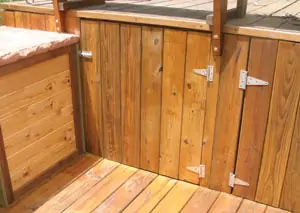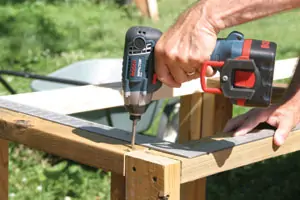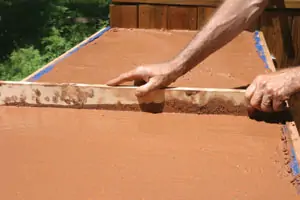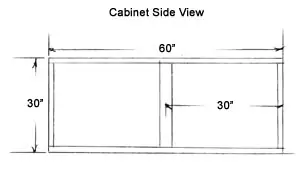By Monte Burch
Create an outdoor kitchen for your next neighborhood get-together
I love to cook outdoors. Not only do I like to grill for family and friends, but I smoke a wide variety of meats, such as brisket, ribs and chickens, sometimes for a full neighborhood party. My fish fryer also gets lots of work-out during the summer months. I probably use the turkey fryer the least, only three or four times a year. Over the years I’ve worked on refining not only outdoor cooking so it’s simple and easy, but the equipment needed as well as a comfortable place to cook. You can, of course do your outdoor cooking any place you can set up a grill, even a small portable grill on a balcony. A specific area designed for cooking not only makes it easier to cook, but to store equipment as well. In many cases outdoor cooking also involves entertaining folks, so you may want to set up your outdoor cooking center suitable to entertaining guests.


The center shown is an add-on, second-level deck below the main deck. The lower deck provides an area for a gas grill, a built-in storage cabinet with a concrete countertop, and space for guests. Adjoining the lower deck is a small brick patio. This provides space for the smoker and fish fryer, or in my case fryers for those times when I fry for a big party. No matter how hard you work at it, fish fryers splatter and drop grease, creating a clean-up and safety problem on a deck. By the same token, smokers require filling with hot coals and ashes, again a safety problem if done on a wooden deck.

The space between the upper and lower decks has doors to create under-deck storage spaces. Depending on your equipment and cooking style you may wish to vary the center to suit your needs.


Deck it First
First step in creating the center shown is to build the deck. This is a straightforward deck construction. The deck shown was constructed of Wolmanized Residential Outdoor Re-dried (air-dried after treatment, ADAT) wood. This makes the wood lighter in weight and ready for immediate finish. A ledger board is fastened to the bottom edge of the upper level deck, making sure it is level. Then lay out the other three sides, using stakes, string line and a string level. The low-level deck shown was supported on pre-cast concrete deck piers, supported on concrete footings. Make sure you follow local codes and regulations on deck support for your area.

Use the triangle system of 3, 4 and 5 feet to lay the deck out square. Or you can build a large 90-degree triangle to check for square. The side headers are then attached to the ends of the ledger board, and the front header fastened between the side headers. Joist hangers provide support for the joists. Non-corrosive fasteners suitable for use with pressure-treated materials were used to assemble the deck.


The deck is covered with 5/4 radius-edge deck boards. The lower deck boards extend beneath the upper deck by 24 inches and are also supported on a joist and piers. This provides off-the-ground storage under the deck for items such as fish fryers, pool covers and other equipment. You can also add a covering under the deck to protect the gear from rainwater. A number of products are available, including: Underdeck (www.underdeck.com), RainEscape (www.rainescape.com) and TimberTech (www.timbertech.com).


With the deck assembled, the space between the upper and lower deck levels is covered over with 5/4 deck boards to match the deck. Two large doors are constructed, again using 5/4 material to provide easy access under the deck. Cleats on the back hold the upright boards together. A cross brace prevents the doors from eventually sagging. Large hinges and a sliding lock keep the doors in place. The deck, as well as the vertical 5/4 facers and doors are all finished with Sikkens Cetol SRD One-Coat wood finish in Cedar tone. A Black & Decker StainStick makes it easy to apply the material to the deck.

A small brick patio on the end of the deck area is laid for the fryers and smoker. For more detailed deck construction, and finishing, as well as laying a brick patio see www.extremehowto.com.

Building the Cook’s Cabinet
The storage cabinet is constructed on the end of the deck and next to the brick patio. Doors on both sides, allow access for equipment for the gas grill on the deck side and for charcoal and frying oil on the brick side for the smoker and fryers. The side facing the deck and gas grill has a shelf.

All frame work for the storage cabinet is pressure-treated lumber. It is not exposed to food prep or food storage. First step in constructing the storage counter is to frame the sides with 2-by-4’s, fastening with 3-inch deck screws. Fasten a center vertical divider/support 2-by-4 in place flush with the outside edges of the top and bottom 2-by-4’s.


The outside frame on the project shown is positioned 4 inches in from the edge of the deck. Place the frame in position and use a square to make sure it is squared with the facers between the upper and lower deck, and is properly spaced from the deck edge.
Level the top, providing a slight raise at the back for drainage. Use wood shims to achieve the level desired. Fasten the bottom plate down to the deck and into the joists. With the bottom anchored, use a level to plumb the back end of the frame and secure it to the upper deck, or vertical facer boards. Assemble the inside frame in the same manner. Locate the inside frame the proper distance from the outer frame, making sure it is square with the vertical facers and again anchor the bottom plate. Plumb the back of the frame and anchor it to the vertical facers. Fasten a 2-by-4 support block between the frames at the back, anchoring it to the vertical facers. Do the same for the bottom, between the frames.
Cut a bottom spacer for the front or outer end and anchor it to the deck, and the bottom of the frames to it. Cut a diagonal brace, plumb up one side and fasten the brace in place. Then cut a top front spacer. This spacer is supported by blocks fastened to the inside edges of the side frames. Position the spacer in place, make sure the opposite frame is plumb and fasten the brace. Then anchor the opposite diagonal brace in place. A center top brace is added, supporting it on 2-by-4 blocks anchored to the center vertical supports.

Create a Concrete Countertop
The next step is to pour the concrete countertop. The countertop shown is poured in place, and the first step is to create the form. The edges of the countertop are formed using a Matcrete split-face granite edge form to create a unique natural-looking stone type texture. Made of high-quality polyurethane, the forms are easy to install. First step is to add a 2-by-4 support form around the cabinet. These are held in place with screws to the framework. In the case of the top shown, an additional 1-1/2 inch spacer was also used to allow for the extra width of the cabinet doors and sides. A 1-by-6 form is then added to the 2-by-4 forms. Then the Matcrete countertop edge forms are installed in place. It’s important the Matcrete edge form extend slightly above the 1-by-6 form boards. The edge form is held in place with finish nails driven from the inside and into the 1-by-6 form boards. The edge form easily wraps around corners without mitering, but you will need a clamp to pull it in place to fasten. The countertop shown utilized slightly rounded corners on the outside. A 1/2-inch plywood sheathing deck is then placed down on the top support boards, leaving space for the overhang. The plywood edges should be bevel cut at a 45-degree angle to provide more edge support. The plywood is anchored to the supports with screws.


The concrete is then mixed, and you can mix your own. Use sand and gravel mix, but you should avoid using large aggregate. The best choice is to buy a bagged mixture. A 5,000-psi bagged mixture such as Quikrete 5000 is the best choice for this type of pour. The countertop shown required three 80-pound bags. One bottle of Quikrete liquid cement color in terra cotta was added to the mix. The cement coloring agent is added to water and thoroughly mixed, then added to the dry concrete mix. Add only enough water at a time to blend the mix and water. For the mix shown you can start with 3/4-gallon of water per bag. A power mixer makes the chore easier, but I made the mix shown in a large wheel barrow using a concrete hoe to mix the ingredients thoroughly.
Once thoroughly mixed, with the coloring evenly distributed, shovel or use a small plastic bucket to pour the concrete into the form, using a trowel to spread it around as needed. You may wish to place drop cloths around the cabinet to prevent getting material onto the wooden deck. Once the form is filled, tap all around the sides with a hammer to settle the concrete and remove any air bubbles. Use a smooth board as a screed to drag off excess concrete, moving the board in a see-sawing motion as you pull off the concrete. Use a trowel to fill in any low spots as you screed and then use a wooden float to remove excess water and further smooth the surface. Allow the concrete to set until it just slightly dents, then use a smooth-faced metal trowel to smooth the surface. The more you trowel and the more pressure you apply, the finer the surface finish will be.


Allow the concrete to cure. For a moist cure, and stronger pour, lightly mist the surface after troweling and cover with plastic sheeting. The countertop should be protected with a concrete sealer to provide protection from water damage, freeze/thaw cycles and chipping. Quikrete Concrete Sealer can be applied while the surface is still damp, but not wet. Or you can apply Thompson Water Seal Concrete Care Sealer 30 days after the pour.


After 24 hours of curing, the form boards were removed. Curing should be continued for five days in warm weather and up to seven days in cold weather. Do not allow the concrete to freeze until completely cured.
The top shown was left as is, but concrete will stain. You can grind and polish the top to a high sheen and use a gloss sealer if you prefer. To grind and polish, use an angle grinder or orbital sander with progressively finer grits, using water as a slurry on the top. Note: Make sure you use a GFCI protected circuit for this chore.

Completing the Kitchen
The next step is to finish out the cabinet by adding the covering and doors. The cabinet shown was covered with Western Red Cedar lap siding and rough-sawn board trim to match the siding and trim on the house. The siding pieces were first treated with Thompson’s WaterSeal Waterproofer, and the trim strips with Thompson’s WaterSeal Waterproofer plus Tinted Wood Protector. Strips of green trim added to the décor.
Green-painted trim strips add to the decor.
The cedar siding for the fixed portions including the end are first fastened in place using stainless steel siding nails. The brown-stained wooden trim strips are added over the siding using stainless steel finish nails. Then the green-painted accent strips are fastened in place with stainless steel finish nails. Wooden facer trim boards are added to the areas surrounding the doors. The doors are constructed using siding and brown-stained trim boards. They are assembled by placing the cut trim siding boards in place on a smooth, flat surface, then attaching the siding boards to their backs with Titebond III wood glue and staples driven from the siding into the trim boards. The doors are hung with hidden hinges and held in place with heavy-duty magnetic catches. Green-painted knobs finish off the cabinet.
Doors are constructed and hung on the cabinet.
Add chairs and a table for entertaining guests while you cook. Deck lighting can also be added both for ambience and night-time cooking. More on deck lighting in a future issue of Extreme How-To.
Materials List
• Side top and bottoms: 2 x 4 x 60”, 4 req’d.
• Side ends: 2 x 4 x 27-1/2”, 4 req’d.
• Side center supports: 2 x 4 x 27-1/2”, 2 req’d.
• End bottom and top supports: 2 x 4 x 17”, 4 req’d.
• Top Center Support: 2 x 4 x 17”, 1 req’d.
• Support blocks: 2 x 4 x 6”, 6 req’d.
• Brown trim: 3/4 x 2” (cut to fit); 53 feet req’d.
• Green trim: 3/4 x 1-3/4” (cut to fit); 16 feet req’d.
• Siding: Lap siding (cut to fit); 77 feet req’d.
• Form boards: 2 x 4 (cut to fit); 16 feet req’d.
• Form boards: 1 x 6 (cut to fit); 16 feet req’d.
• Edge form: 152” req’d.
• Concrete: 80# bags Quikrete; 3 req’d.
• Concrete color: one bottle
Outdoor Cooking
The Extreme Ho-To staff loves to cook, and here are some recommended cookers for your backyard retreat.
Monte Burch — “I’ve been using a Good-One charcoal smoker for many years. It’s an indirect heat, dry smoker. It doesn’t have a water pan as do some smokers. This type of smoker provides true, pit-barbeque flavor and is extremely easy to use. Merely fire up the charcoal, add some wood chunks and adjust the dampers. The smoker will cook at 225 degrees for hours without needing attention.
I’ve also used fish and turkey fryers from Bass Pro Shops for many years and their Stainless Steel Steamer/Fry Combo is an excellent choice. It comes with everything you need for frying and steaming, including a 10-1/2 quart stainless steel pot with basket and a large 30-quart pot with lid, strainer rack and lifter.”
Matt Weber — “I’m partial to the Big Green Egg, a ceramic ‘kamado style’ smoker that looks like it sounds. It serves as a smoker, a grill and an oven. Use it to smoke turkeys, grill steaks or bake a pizza; it all turns out great. The ceramic walls evenly retain heat for easy temperature control without hot spots, and the end result is some of the juiciest meats you’ve ever grilled. I’ve had one for about 3 years and swear by it. I even bought one for my dad”.









